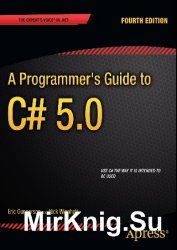
Автор: Eric Gunnerson, Nick Wienholt
Название: A Programmer's Guide to C# 5.0, 4th edition
Издательство: Apress
Год: 2012
ISBNL 143024593X; 9781430245933
Серия: Expert's Voice in .NET
Язык: English
Формат: pdf
Размер: 31,2 mb
Страниц: 442
Whether you’ve worked with C# before or with another general-purpose programming language, each fast-paced, focused chapter will take you straight to the heart of a feature of C# and show you why it works the way it does.
Written by one-time C# Test Lead, Program Manager, and member of the original C# language design team, this book is an ideal companion to the C# Language Specification, and works both as a tutorial and as a reference guide. Now in its fourth edition, you will find up-to-date coverage of all the latest C# features, including Linq, covariance and contravariance, and async support.
You’ll learn how to:
•Use C# features effectively, in the way they were intended
•Apply the newest C# features to your coding problems
•Streamline your database code using LINQ
•Use async support and the task parallel library to improve performance.
•Program more efficiently, effectively, and with real insight into this mature and exciting language, with A Programmer’s Guide to C# 5.0.
Preface
About the Authors
About the Technical Reviewer
Acknowledgments
Introduction
Chapter 1: C# and the .NET Runtime and Libraries
Chapter 2: C# QuickStart and Developing in C#
Chapter 3: Classes 101
Chapter 4: Base Classes and Inheritance
Chapter 5: Exception Handling
Chapter 6: Member Accessibility and Overloading
Chapter 7: Other Class Details
Chapter 8: Structs (Value Types)
Chapter 9: Interfaces
Chapter 10: Versioning and Aliases
Chapter 11: Statements and Flow of Execution
Chapter 12: Variable Scoping and Definite Assignment
Chapter 13: Operators and Expressions
Chapter 14: Conversions
Chapter 15: Arrays
Chapter 16: Properties
Chapter 17: Generic Types
Chapter 18: Indexers, Enumerators, and Iterators
Chapter 19: Strings
Chapter 20: Enumerations-
Chapter 21: Attributes
Chapter 22: Delegates, Anonymous Methods, and Lambdas
Chapter 23: Events
Chapter 24: Dynamic Typing
Chapter 25: User-Defined Conversions
Chapter 26: Operator Overloading
Chapter 27: Nullable Types
Chapter 28: Linq to Objects
Chapter 29: Linq to XML
Chapter 30: Linq to SQL
Chapter 31: Other Language Details
Chapter 32: Making Friends with the .NET Framework
Chapter 33: System.Array and the Collection Classes
Chapter 34: Threading
Chapter 35: Asynchronous and Parallel Programming
Chapter 36: Execution-Time Code Generation
Chapter 37: Interop
Chapter 38: .NET Base Class Library Overview
Chapter 39: Deeper into C#
Chapter 40: Logging and Debugging Techniques
Chapter 41: IDEs and Utilities
Index
|